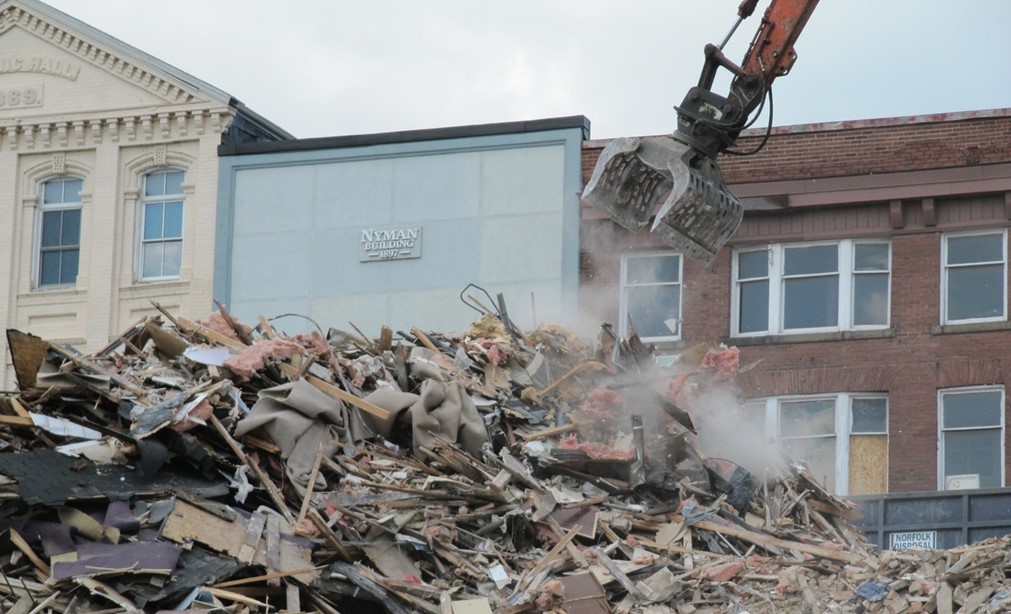Construction waste is a big problem for everyone involved. On site, it incurs extra expenses with disposals and can also lead to costly delays in the construction.
On a grander scale, it’s a major budget cost for local governments and is fast dwindling landfills. Major cities are running out of landfills (New York ran out as far back as 2001).
In Wisconsin, construction materials such as wood and concrete make up one-quarter of landfill waste each year.
There’s also the obvious and very real environmental implication—reportedly, at least 40% of the world’s carbon dioxide emissions is generated by C&D waste.
To combat these problems successfully, construction professionals need to become familiar with proper waste management practices on site. They also need to adopt efficient demolition and waste disposal methods.
We will cover these topics in this article.
Table of Contents
- Common causes of construction waste
- What are the types of construction waste?
- Standard disposal methods of non-hazardous construction waste
- Standard disposal methods of hazardous construction waste
- More Efficient Methods of Construction Waste Management and Disposal
Common causes of construction waste
Generating waste is a natural part of any construction and it’s not something that can be totally avoided. Most contractors have to order an over-surplus of materials since it’s safer to do so and avoid delays due to material shortages.
However, demolition is the biggest culprit—generating up to 90% of construction waste.
Another cause is the fact that effective C&D waste management habits aren’t so popular. As a construction dumpster rental company we’ve had to rent multiple dumpsters to sites that could do with less if only they were more intentional with their waste management approach.
What are the Types of Construction Waste?
Any general contractor or construction professional can classify construction waste, but for reference, we will do so here.
You can skip this section and jump straight to proper waste disposal and management practices below.
Construction waste can be broadly classified into two categories: hazardous and non-hazardous waste.
Non-hazardous construction waste includes materials that are not harmful to human health or the environment. This waste can often be recycled, reused, or safely disposed of in landfills.
On the other hand, hazardous construction waste poses risks to humans and the environment. It requires careful handling and proper disposal.
Standard Disposal Methods of Non-Hazardous Construction Waste
To dispose of non-hazardous construction waste safely, here are several methods you can employ:
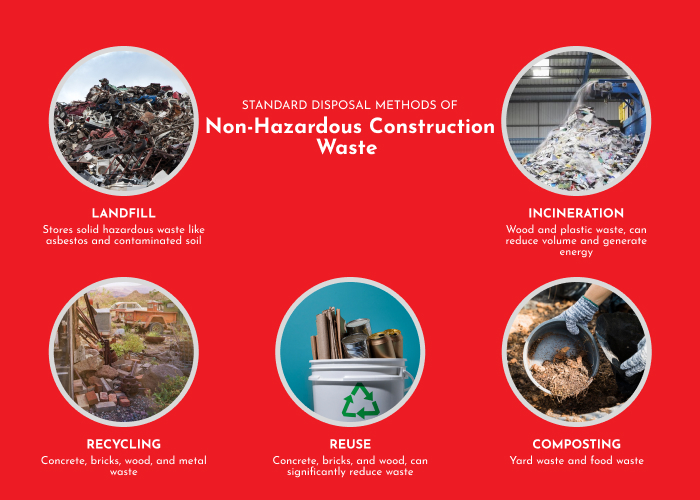
Standard Disposal Methods of Hazardous Construction Waste
Here are several methods for safely disposing of hazardous construction waste:
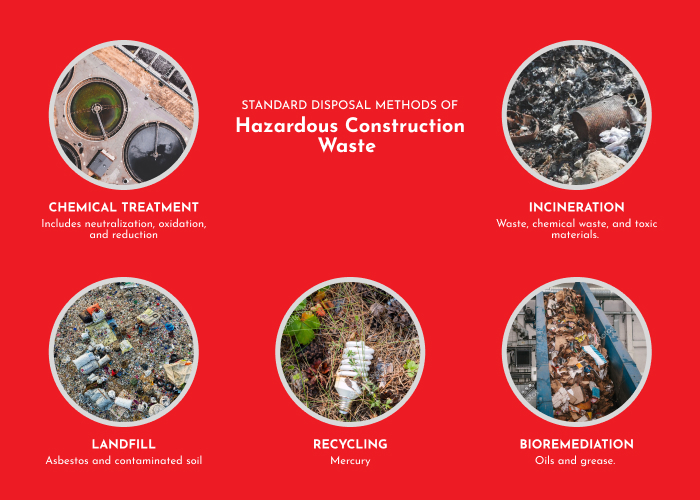
More Efficient Methods of Construction Waste Management and Disposal
To generate less waste during construction, you should do the following:
Create a Construction Waste Management Plan

Before starting any construction project, create a waste management plan that outlines waste reduction measures, recycling options, and disposal methods. Regular waste audits should also be scheduled.
Let’s explore the key factors to consider when creating an effective construction waste management plan:
Designate Recycling Coordinators: To kickstart your waste management plan, appoint dedicated recycling coordinators. They will be responsible for overseeing waste segregation, recycling efforts, and ensuring compliance with waste management protocols.
Implement Waste Segregation Systems: Set up proper waste segregation systems on-site. This involves providing clearly labeled bins for different types of waste, such as recyclables, non-recyclables, hazardous materials, and organic waste. Educate workers on how to separate and dispose of waste correctly
Analyze Anticipated Waste: Take a close look at both construction and demolition activities to anticipate the type and volume of waste to be generated. By understanding what waste you can expect, you can plan for its proper disposal or recycling.
Costs of Waste Disposal: Waste disposal can be costly, so it’s crucial to factor in the associated expenses. Consider budgeting for waste removal, transportation, and potential fees at disposal facilities.
Identify Proper Waste Processors: Do your research and identify reputable facilities that specialize in processing construction waste. Look for those with a track record of environmentally friendly practices and proper permits.
Consider Waste Minimization Strategies: There are other ways to minimize waste generation in the first place. These can include using prefabricated or modular construction methods, implementing lean construction practices, and optimizing material use to avoid excess waste.
Monitor and Track Progress: Regularly monitor and track your waste management efforts to evaluate their effectiveness. Keep records of waste generation, recycling rates, and any cost savings achieved through waste reduction or recycling initiatives. This data will help you identify areas for improvement and celebrate successes.
Keep It Simple and Practical: Avoid getting caught up in complex jargon and overwhelming details. Keep your waste management plan simple and practical, ensuring it can be easily understood and followed by everyone involved in the construction project.
Educate and train construction workers

Waste management isn’t just about what happens after the waste is generated. You should also focus on on-site habits that can reduce waste
Encourage workers to handle waste responsibly, promote recycling, and minimize the generation of unnecessary waste.
Raise awareness about proper waste disposal practices, waste reduction strategies, and the importance of recycling. Training programs can go a long way in achieving this.
Hire a dumpster rental
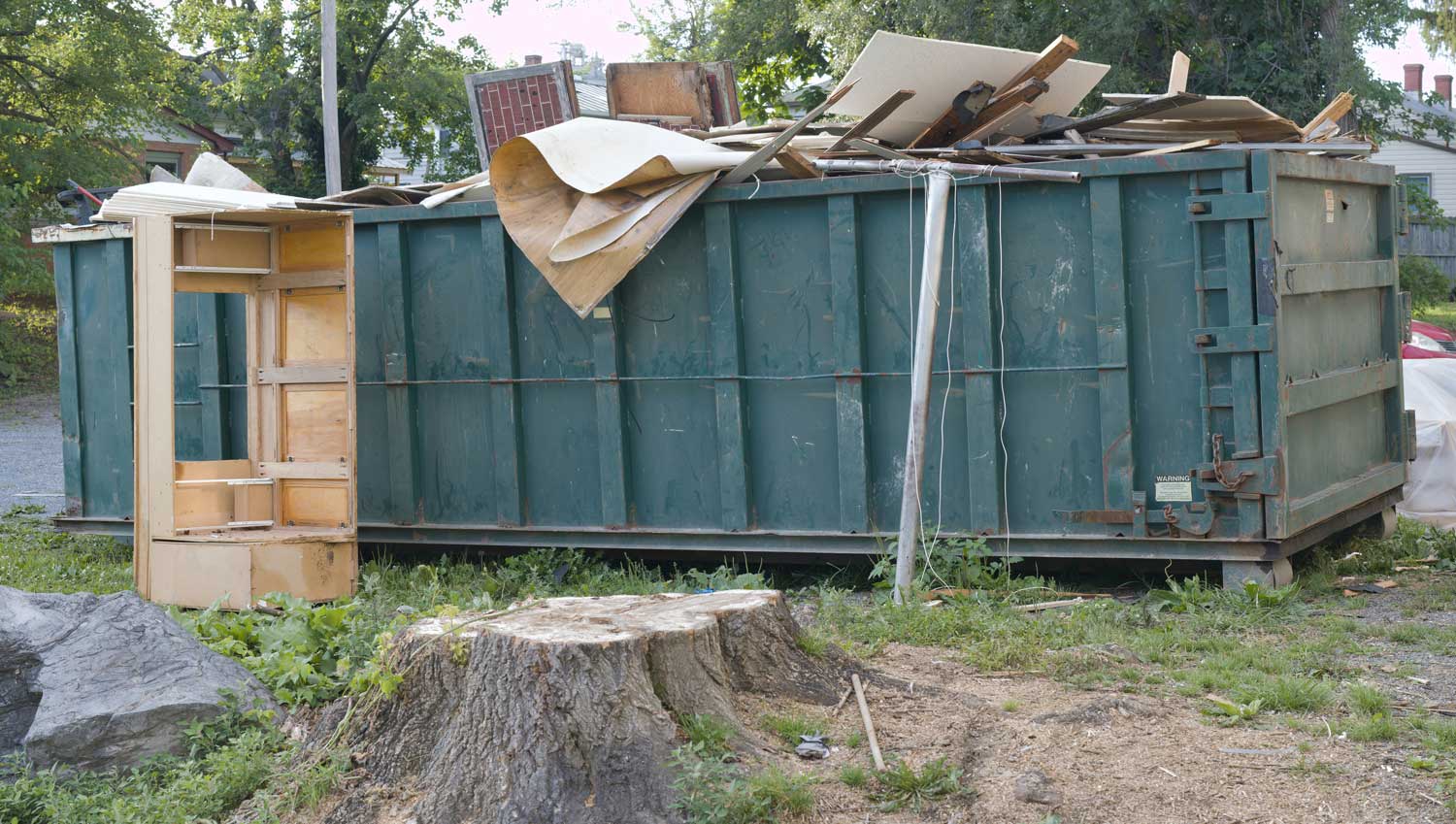
Dumpster rentals are the most convenient method of waste disposal. They can take care of waste segregation and save you the hassle, ensuring different types of waste are separated correctly.
They’re not just efficient; they’re also cost-effective. For large construction projects, renting a dumpster eliminates the need for expensive waste transportation. They handle it all, saving time and money that can be invested back into construction work.
Construction dumpster companies are equipped with the knowledge and tools to implement environmentally-friendly waste management solutions. They understand the importance of recycling and can guide recycling efforts for your construction waste.
Use Mercury Agencies
Mercury, a highly toxic substance, is often found in various items, including thermometers, lamps, smoke detectors, fluorescent light bulbs, and old paint.
These items may seem harmless at first, but when improperly disposed of (throwing them in landfills or incinerators, for instance), they can release mercury into the air, soil, and water, leading to contamination and health risks.
To prevent such harm, it is crucial to identify and separate mercury-containing items from other construction waste.
Once identified, these items should be taken to specialized agencies or consolidation sites that handle mercury disposal. These agencies have the expertise and equipment to safely collect, transport, and dispose of mercury-containing waste.
Here are ways you can safely transfer mercury-containing items to mercury collection agencies:
Identify Mercury-Containing Items: Look for any items that may potentially contain mercury in your construction waste. These can include thermometers, lamps, smoke detectors, and old paint cans.
Handle with Care: When dealing with mercury-containing items, it’s essential to handle them with caution to avoid breakage and the subsequent release of mercury. Use gloves and avoid direct contact with the items.
Contact a Mercury Collecting Agency: Research and find a certified mercury collection agency in your area. Contact them to inquire about their collection procedures and requirements.
Proper Packaging: Follow the guidelines provided by the agency for packaging and transporting the items. This may include using leak-proof containers or sealed bags to prevent accidental spills.
Do a Construction Site Management Audit

A construction site management audit involves a comprehensive assessment of the construction site’s operations, including waste management practices.
Regarding waste management, it can help uncover potential flaws or inefficiencies in your approach. It also ensures compliance with regulations and promotes efficient waste handling. Think of it as a check-up for your waste management process!
Who is involved in a site management audit?
A site management audit typically involves the following individuals and their responsibilities:
Project Managers: They oversee the entire construction project and play a vital role in implementing waste management strategies. Project managers are responsible for coordinating the audit, ensuring its completion, and addressing any issues identified.
Site Supervisors: Site supervisors oversee day-to-day operations and are directly involved in waste management on the construction site. They work closely with project managers to implement waste management plans, monitor progress, and make adjustments as necessary.
Contractors: Contractors working on the construction project play a crucial role in waste management. They are responsible for segregating waste, following proper disposal procedures, and ensuring their employees are educated on waste management practices.
The site management audit has a positive impact on waste management if all involved parties collaborate and aggressively enforce waste management as a key factor.
Avoid contaminating construction waste with everyday trash
Make sure that construction workers are aware of what constitutes everyday trash and what should be considered construction waste.
Everyday trash, like food wrappers or personal items, should be properly disposed of in designated waste bins. This helps you focus more on construction waste management.
You should also designate areas for waste disposal throughout the construction site. Clearly label bins or containers for different types of waste so workers can discard materials correctly. This reduces the likelihood of mixing construction waste with everyday trash, or vice versa.
Do Selective Demolition and Salvage Useful Items
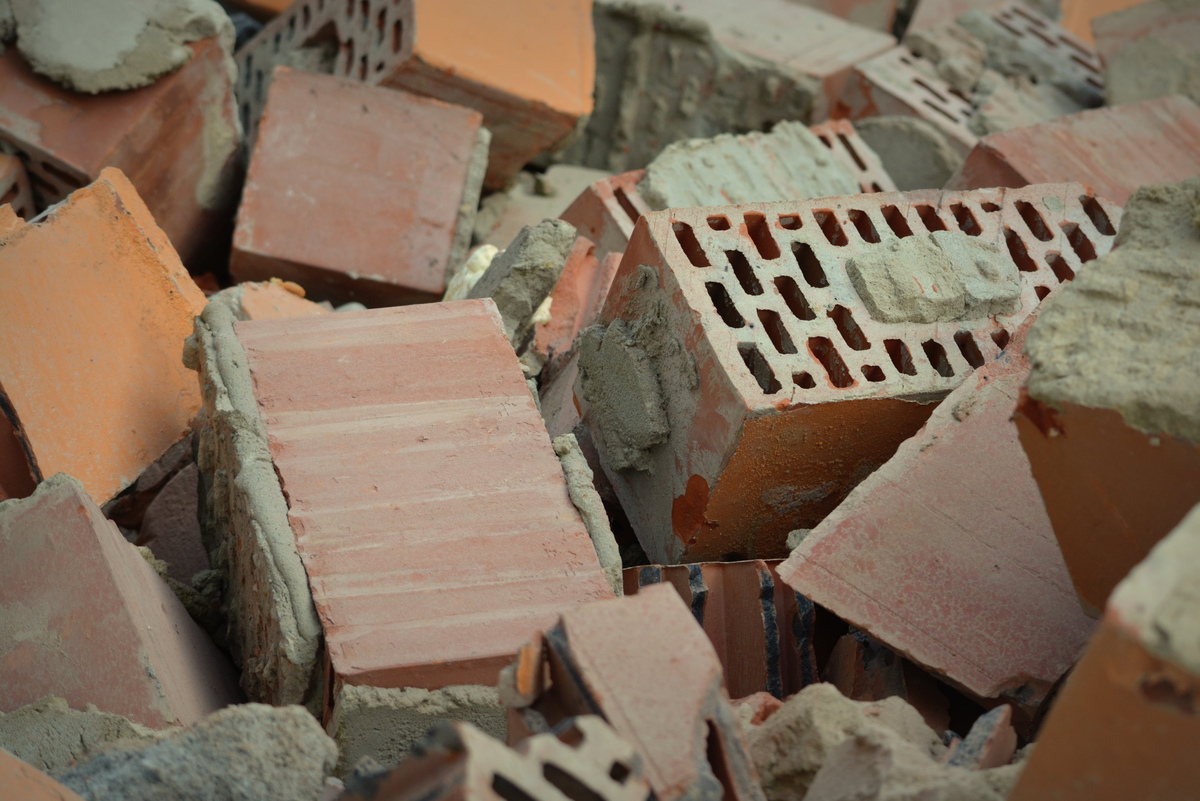
Instead of tearing down everything in sight, why not carefully dismantle and salvage materials that can be reused or recycled?
Selective demolition involves identifying and removing specific components or materials from a structure while preserving the rest. This not only reduces waste but also saves money by salvaging valuable materials.
For example, if you’re renovating a building, you can carefully remove fixtures, doors, windows, and even structural elements like beams or flooring for future use. The Wisconsin Department of Natural Resources has specified materials that can be reused or recycled.
Salvaging materials not only benefits the environment but also gives you the opportunity to save on purchasing new materials.
Reclaimed wood, for instance, adds a unique touch to your construction project while reducing the demand for newly harvested timber. Plus, salvaged materials often come with a rich history and character that new materials simply can’t replicate.
But how do you go about selective demolition and salvaging? Here are a few tips to get you started:
Plan ahead: Before starting any demolition work, assess the structure and identify materials that can be salvaged. Consider consulting with salvage experts or architectural salvage yards to determine what materials have value and can be reused.
Careful deconstruction: Instead of using heavy machinery to tear everything down, take a more careful approach. You can disassemble some components by hand and light machinery to avoid damaging the salvaged materials. This requires more time and effort, but the results are worth it.
Material sorting: As you dismantle the structure, sort materials into different categories for recycling or reuse. Create separate piles for wood, metal, glass, and other salvageable items. This makes it easier to process and transport the materials to their respective destinations.
Salvage storage: Once you’ve collected salvaged materials, store them in a safe and organized manner. This ensures that they remain in good condition until they can be reused or sold. Consider labeling and storing them in a covered area to protect them from the elements.


